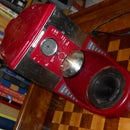Introduction: Repair an Old Classic Book (rebinding).
I became interested in reading the old book "Moby Dick" because of a radio program where they discussed the qualities of the story. But when I went to all the bookstores, they only had drab dreary NEW copies of the book. They had NO pictures... and NO "character." When I held the new book in my hand, I didn't even WANT to read it. So I searched EBAY for an old copy and it is a WONDERFULL book! It has PICTURES... it is almost 100 years old!... and it has lots of character! but it needed repair. So I bought it for $12.00 and set about the job of re-binding and restoring it.
I have only restored 2 small paperbacks previously... so this was a bit of a challenge for me. I don't claim to be a professional book-binder. That was not my goal. I wanted to accomplish 2 things: 1... get this book back into usable condition.. and 2... Improve my bookbinding skills. If you have never done this before, i suggest you start with a paperback book that is not an expensive treasure. So lets get started with the items you will need....
Step 1: Items You Will Need:
You will need a few common items to fix your book. I used some GIANT "C" clamps. They worked ok but I believe a smaller set of clamps would work better. Next time I do this, I will try some "squeeze" clamps that look like large clips. As long as they are big enough to hold the book, they should work. I used some heavy duty thread and large needle. Anything that is strong would work ok Kite string or upholstery thread would work ok. But dont use regular THREAD. It is too thin for this purpose. I purchased PVA glue. PVA is Poly-Vinyl-Acetate. It is a glue SIMILAR to white "Elmers" glue. It is a higher quality glue though that has more FLEXIBILITY and more TACKYNESS and is ACID FREE to protect the books paper. Do not substitute other glues because you must use a glue that is FLEXIBLE and very tacky. You will need a couple THIN wood slats like the one laying on the top of the book. This will be used as a DRILLING helper. Scissors and an electric drill motor with small drill bit (1/8th inch) are also needed. ALSO needed but not pictured is some vinyl upholstery cloth. I bought the CHEAPEST kind because it was thinner and more flexible. You could also use any old heavy duty cloth material that you think would look good on the book. Also, i used a small piece of BURLAP material because of its loose weave would help hold the glue.
Step 2: Line Up the Edges for Clamping
It is very important to get the pages "squared-up" before clamping. My book had a curved shape to the spine... which made this difficult. Professional bookbinders use a special "JIG" to line up all the book edges. We are not so lucky. I had good success just using a piece of wood and being carefull to clamp the book with all edges lined up pretty close.
Step 3: Clamping the Book Before Drilling:
You MUST clamp the book using a couple scrap wood slats as pictured here. If you try to drill the pages WITHOUT doing this you will make a big MESS of the book. The reason is because the drill bit will gouge into the paper and the paper shavings will NOT come out of the hole very will. Instead, the shavings will "expand" inside the books pages and make the pages "puff'-out" So place your clamps on the wood-slats carefully while KEEPING the page edges evenly lined up.
Also, you want the edge of the wood-slat lined up with the edge of the book spine as shown in the picture. You will be drilling close to the edge of the wood so line it up carefully.
Step 4: Clamping Done... Ready to Start Drilling.
My clamp is positioned and the binding is ready to drill. You can see the LARGE clamps i used are too big and kind of "in the way." But they worked and now I can start drilling the spine.
Step 5: Drilling the Books Spine. SAFETY ISSUE !!
I set my drill bit into the "drill-chuck" so that the drill bit DOES NOT exit out the other side of the board. This is somewhat important for SAFETY. If you allow your drill bit to exit the other side, you must be VERY CAREFULL not to drill into your fingers!!! I do not like to drill into my fingers, so i made SURE this would not happen by using this simple tip. Please study this picture carefully. I am NOT SHOWING where to drill in this picture. I am showing the DRILL BITS LENGTH is not going to PENETRATE the wood!! When we start drilling, we will drill near the spines EDGE, Not way up here where the bit is in this picture.
Step 6: Drilling the Books Spine :
I drilled using a hand held drill motor. A drill-press would work better and would insure drilling straight to the other side and not at an ANGLE. I trusted my drilling ability to go STRAIGHT enough ... but a few times my drilling was "OFF" a little. But it didn't make much difference in the final book project. I suggest if you use this method to drill a hole then SKIP a spot. Drill a hole... then skip a spot... all the way along the spine. Then drill the "skipped" areas from the OTHER side of the book. The clamps will be in your way for some of the holes. You will need to move one clamp at a time to drill those holes. Do not let the pages move... or none of your drilled holes will line-up for the SEWING step!!! Work slowly and carefully..
Step 7: Move the Clamps Away for the SEWING Step :
All of my holes are drilled, and now i want to stitch the spine together.. So the clamps and boards must me moved away to allow the stitching. Move ONE clamp at a time and carefully slide the board away from the book edge. If the pages move then your holes will not line up for sewing so work carefully and slowly when moving your clamps and boards. When done, i took this opportunity to clean up the loose crud on the book spine. Old dry glue and paper frazzles i scratched off of the spine.
Step 8: Sewing the Spine :
I used my large sewing needle and extra thick upholstery string to sew up the binding. I pulled the thread SNUG but not too tight because the paper is easily damaged. Don't pull strings TOO tight because the paper might tear. I then smeared the PVA glue all over the glued edge being carefull so the glue doesn't drip where it ISNT needed.
Step 9: Restoring the Books Cover :
I decided to RE-USe the old book cover because it is the RIGHT size and it worked out great. I just glued the cover FACE DOWN onto the new fabric. I cut out the corners of the fabric and folded/glued it as shown in the pictures here. I added the burlap INNER lining to give the pages spine something to ADHERE to.
Step 10: Finishing Up the Book:
I used a simple GOLD SPRAY to "fix" the gold-leaf that was worn off on the page edges.. I probably should have used some SPECIAL gold paint that was acid free... but i got carried away during the project and started SPRAYING before I started THINKING. Oh well, it LOOKS good. I dont know how this will affect the paper over the years. So it worked for me. You may want to skip this step or purchase something more suitable for old books. I then scanned the picture of the original cover. Lucky me, there was another copy of that picture INSIDE the book that had no fade in the colors... so i used a picture editing program and typed the BOOK TITLE. I went down to Walgreens for them to print the picture so it would be better INK and PAPER that my inkjet printer cant compete with. I wrapped the picture with protective plastic and used LIQUID NAILS glue to attach this picture to the FRONT of the book. I finished off the book by placing some METAL CORNERs on the book cover. If you do this, be carefull to not let anything METAL touch the books pages... because the metal will rip a hole in the pages QUICK. I put little screws into the metal corners... but later removed them because they were damaging the papers inside the book. That about finishes the book. It is very impressive and everyone who sees it is somewhat surprised that the book is almost 100 years old and so nice to hold. This book has CHARACTER.













